Angela Hartlin's Blog
November 13, 2020
BFRB Virtual Support Groups
With 2020 bringing us the pandemic and its associated stresses, many dermatillomania and BFRB in-person peer support groups have transitioned to an online format! While BFRBhalifax is still open to Nova Scotia residents, I created Skin Picking Support on Facebook to provide monthly support through virtual meetings.

Meeting days alternate between Saturday and Sunday
7:30am PST/ 10:30am EST/ 11:30am ATL/ 3:30pm BST
If you are unable to attend Skin Picking Support meetings or want additional virtual support, TLC Foundation for BFRBs, Canadian BFRB Support Network, and Picking Me Foundation have various online meetings and events to check out below:



Other independent groups offering support through online meetings include:

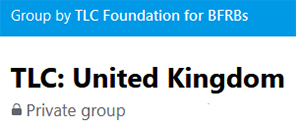
Support is available across the world and in various time zones. If you’re looking for a therapist trained in BFRB treatment, click here to find a professional in your area.
During these trying times, please know you aren’t alone.
Check out the five star documentary Scars of Shame and Angela’s ground-breaking memoir FOREVER MARKED: A Dermatillomania Diary. Like Angela on Facebook, follow her on Twitter, and join her on Instagram. Subscribe to her blog for updates on her recovery book, Embracing Dermatillomania: Through Pain & Recovery.
July 13, 2020
My Challenges During Pregnancy
Despite being in recovery from dermatillomania since 2015 with a few minor blips along the way, I wasn’t sure what to expect from my skin picking disorder when I became pregnant in May of 2019. With body-focused repetitive behaviors (BFRBs) having links to hormones I prepared myself that my recovery success could fall apart during my pregnancy.
I’ve always wanted to be a mother and almost had that dream ripped from me due to my six year battle with piriformis syndrome that ended with me traveling to Nevada, USA, to get surgery in August of 2018. Three months later, I was pregnant and due on the 1 year anniversary date of the surgery. Life seemed to be coming together for me although I still battled with negligent health care regarding treatment for my hip condition (FAI) that was exacerbated by piriformis syndrome over the years.
Sadly, I miscarried with a blighted ovum during December of 2018 and was unsure of if I’d ever become pregnant again. Falling into a depression from the miscarriage, I started slipping into skin picking with my face. With my hips worsening I knew that my time was limited because of how close I was to being in too much pain again to endure a pregnancy. By the last month of trying, I had to break the news to my husband that we wouldn’t be trying after May because both hips had really started affecting me.
By a miracle, I was pregnant the month after this video! By June 28th, I developed morning sickness that gradually got worse and didn’t go away until three weeks after I gave birth. I lost a lot of weight and had another symptom I hadn’t heard of: dysgeusia, in the form of an extremely foul and sour taste in my mouth, which also lasted the duration of my pregnancy although it improved as time went on.
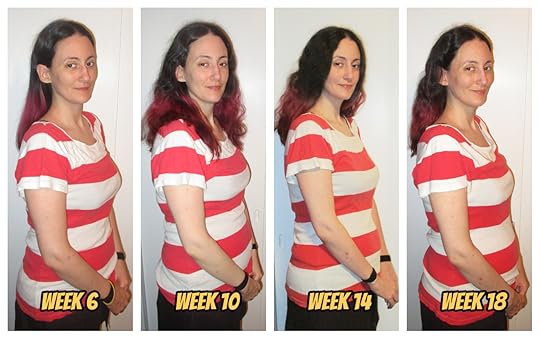
My vomiting multiple times a day improved with my third medication by the 17th week but my nausea never subsided. My picking slowly got out of control because of how hard it was to handle being so dreadfully sick, with my depression worsening to the point I felt like I was living hour by hour just to get by.
The day before my wedding anniversary in 2016, I experienced a medical trauma that caused me to have severe panic attacks and resulted in me becoming fearful of vomiting. Then I became fearful of eating and going to sleep at night because I’d wake up in a full-blown shaking, sweating, hyperventilating panic attack. I had also lost a lot of weight between 2016 and 2018 from my new phobia. In terms of my ability to cope, this was my worst nightmare for a pregnancy. I was lucky that my hip pain subsided temporarily because of pregnancy hormones, but it has since been re emerging with my appointments for an MRI (STILL waiting, if you saw the first video) and orthopedic surgeon being put off because of the pandemic. This is hard to swallow, knowing that the waiting list for hip surgery is up to five years in Nova Scotia during normal times.
I counted the days and made mental notes of milestones to get through the awful Hyperemesis Gravidarum (HG) pregnancy. By the 30th week, my skin picking exploded after I found out that something may be fatal or severely disabling for the little girl inside of me. Two weeks later, I was relieved to find out that the ultrasound wasn’t read correctly but during that time I couldn’t process how everything I had gone through could end up in a total disaster.

My daughter, Violet, was born on Feb. 12th, 2020 in the first percentile and stayed in the NICU for 10 days. My hormones weren’t activated during my pregnancy but after giving birth, I was a mess and even thought I would have to be admitted over how upset I was at everything. Strangely, I didn’t pick at this time, but it is likely because I had no time to with staying in the NICU with Violet as much as possible.
Between the pandemic starting five weeks later and my mother developing breast cancer weeks into the lock down while I’m trying to be a mom myself for the first time, my facial picking hasn’t been great. I am grateful for all the support I received through my old gofundme for the piriformis removal in 2018 because it led to my life improving in more ways than just physically. My wonderful husband and I are blessed with a healthy and happy daughter who has captivated our hearts and that of everyone who has met her!
We cannot thank Dr. Tollestrup enough for specializing in this condition so that many people, like myself, had the chance to turn our lives around. I couldn’t have done any of this without the support of many of you who supported me during rough patches and helped me reach my surgery (actual video- WARNING) goal. I have had to fight for my life a few times, but it’s all worth it because I now have Violet enriching it. I know I have the tools to improve my picking but life is so chaotic right now that I am trying to be kind to myself, and I have confidence that when things settle I can use my tools to manage my urges again.
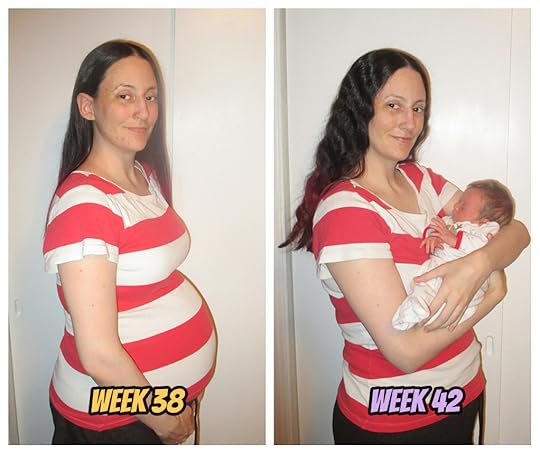
I can’t thank you all enough for your love and support over the years. I hope I will be able to give it back to you next year when I hope to release my long-awaited recovery book, EMBRACING DERMATILLOMANIA: Through Pain & Recovery.
Check out the five star documentary Scars of Shame and Angela’s ground- breaking memoir FOREVER MARKED: A Dermatillomania Diary. Like Angela on Facebook, follow her on Twitter, and join her on instagram. Subscribe to her blog for updates on her recovery book, embracing dermatillomania:Through Pain & Recovery.
October 24, 2019
The #1 Misconception About Dermatillomania

Awareness for dermatillomania and other body-focused repetitive behaviors (bfrbs) has magnified over the last decade. In 2013, the DSM 5 recognized compulsive skin picking as “excoriation disorder”, categorizing it under a new “obsessive-compulsive and related disorders” section in the mental health diagnostic manual.
While efforts have gone a long way to inform a higher percentage of the population about the existence of BFRBs, people with visible marks can be mistaken for having a skin disorder, or a stigmatizing condition such as AIDS. People with dermatillomania can also be stereotyped as unhygenic, based on tropes that people with acne don’t take care of their hygiene or diet. These immediate judgments can have devastating emotional consequences for someone sensitive to the appearance of their skin, causing them to isolate and have an increase of social anxiety (among other possibilities).
The most common suggestion people who compulsively skin pick get is that they are taking drugs. One symptom of heroin or opioid use can be getting itchy skin, which manifests by the person picking at their skin to relieve the physical sensation. In methamphetamine users, the stimulant can also cause delusional parasitosis which makes them to believe they are infested with living organisms (such as bugs or parasites). While excoriation disorder is a different condition altogether, there is more public awareness about the effects of narcotics than there is for BFRBs.
Social stigma for dermatillomania is high, especially when someone can’t grasp how a person cannot stop a repetitive behavior that causes damage to the skin. The stigma for drug users is much more enforced in society because of discriminatory beliefs about them. From thinking they’re “weak”, “criminals”, “strains on society”, “dirty”, “unworthy”, among many other unfair assessments, these labels can be placed onto people with dermatillomania.
It can affect future job prospects. It potentially determines whether a doctor will pay attention to your concerns in an ER, or believe you’re “drug seeking”. People with skin lesions are susceptible to being stereotyped by law enforcement, becoming targets instead of being seen as credible.
Whether or not a person’s picking is the result of drugs, mental health, or both, we should all agree that it is unfair to judge a person based on their skin. Those with addictions are not any less worthy of compassion, empathy, or help for their behavior than we are. The struggle may differ from ours, but we relate in our experiences of rejection from others and the judgment that comes with not having “acceptable” coping mechanisms.
Check out the five- star documentary Scars of Shame and Angela’s ground- breaking memoir FOREVER MARKED: A Dermatillomania Diary. Like Angela on Facebook, follow her on Twitter, and join her on Tumblr.
July 8, 2019
Resource Review: Sandy Rosenblatt’s “Doesn’t It Hurt?…”
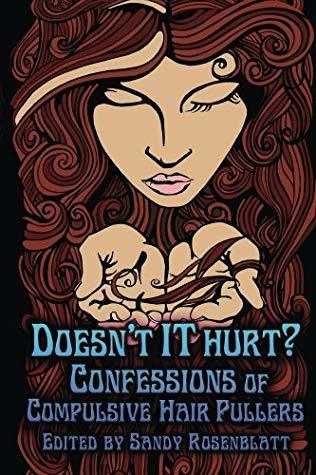 Similar to the Project Dermatillomania series, Doesn’t It Hurt? Confessions of Compulsive Hair Pullers by Sandy Rosenblatt is a compilation of real stories from people who have trichotillomania. As suggested in the title of this anthology, trichotillomania is a disorder that causes a person to pull out their hair compulsively. In the last diagnostic manual of mental health (DSM IV), trichotillomania was categorized under Impulse-Control Disorders. Currently, the DSM 5 has both trichotillomania and excoriation disorder (aka dermatillomania) falling in the Obsessive- Compulsive and Related Disorders category.
Similar to the Project Dermatillomania series, Doesn’t It Hurt? Confessions of Compulsive Hair Pullers by Sandy Rosenblatt is a compilation of real stories from people who have trichotillomania. As suggested in the title of this anthology, trichotillomania is a disorder that causes a person to pull out their hair compulsively. In the last diagnostic manual of mental health (DSM IV), trichotillomania was categorized under Impulse-Control Disorders. Currently, the DSM 5 has both trichotillomania and excoriation disorder (aka dermatillomania) falling in the Obsessive- Compulsive and Related Disorders category.
Unofficially, trichotillomania and dermatillomania are classified by a variety of disorders called body-focused repetitive behaviours (BFRBs). These disorders may not manifest the same way, but they are driven by a similar urge for relief through a behavior. Rosenblatt’s book highlights many sentiments we have faced in the dermatillomania community: shame, embarrassment, isolation, secrecy, and a hope to overcome one of the greatest challenge of our lives.
I have met many of the contributors of this book, including Rosenblatt herself, at previous TLC conferences. The first story comes from Katherine, a young woman who Sandy and I sat alongside on a success panel at a 2013 conference. She explains how much deeper trichotillomania is than its physical side effects; it’s “mentally crippling” and “emotionally exhausting”, while people (including doctors) dismissed her concerns. I relate to her struggle for a diagnosis, cycling through several professionals, and feeling like a “freak”, which also affected her view on dating and lead her down a path of suicidal tendencies. While she had maintained her recovery for years, after the release of this book I learned that Katherine relapsed, but has been 8 months pull-free as she hopes to give even more back to the community through her masters in mental health counseling.

L-R: Sandy Rosenblatt, Angela Hartlin, and Laura Barton TLC Conference, 2015
Without summarizing each story, many of the themes of the book include childhood memories, school experiences, being parented (not always appropriately), and overall how the writers viewed themselves with a disorder they had no power over. The most noticeable feature that ties all stories is how much personal growth each writer shares, ending each with hope that even if you do not have the tools to overcome trichotillomania, you can still find solace by speaking to others with the disorder. And no matter what, it’s possible to love yourself more than you may today.
It may not be easy to eradicate the shame. As someone who has written a thesis on trichotillomania, Sebastian discusses how he is smart and has accomplished many things in his life, but that “not being able to ‘fix’ the fact that I pull out my hair has always plagued my mind and made me feel so awfully incompetent.” While many people with BFRBs share this sentiment, being a male with trichotillomania has additional challenges such as the discrimination for men to “suck it up” when it comes to mental health, and how trichotillomania predominantly affects women.
The forward in the book mentions that 1 in 50 people have trichotillomania. Of that percentage, roughly 80%- 90% of its sufferers are female. Rosenblatt includes stories worldwide from males and females of all ages in order to represent as many people as possible. Hopefully Rosenblatt will make a sequel that will include more people of color, the LGBTQ+ community, and people of various backgrounds so that she can continue to diversify the voices in the BFRB movement.
Rosenblatt includes her story at the end of the book. Instead of sharing my thoughts on her brave journey, I’ll let you hear her experiences below so that you must get to know the incredible woman responsible for bringing together 15 people for a moving compilation:
If you are a person who chooses a book by its cover you will not only be pleased with its beautifully framed artwork, but you will empathize with the powerful stories of pain and perseverance told through the lens of incredibly articulate survivors- many who have taken professional paths to work toward acceptance and healing from BFRBs. Whether it be through advocacy, becoming a therapist, or researching on behalf of the cause, it’s inspiring to know that there are many people who have gone through similar trials and have made a difference within our community so that no one else has to feel alone.
If you would like a copy of Doesn’t It hurt? Confessions of Compulsive Hair Pullers, please visit amazon. follow Doesn’t It Hurt?… on Facebook, Twitter, and goodreads! To learn more about Rosenblatt, check out her huffington post articles!
April 23, 2018
How to Accept Your Dermatillomania
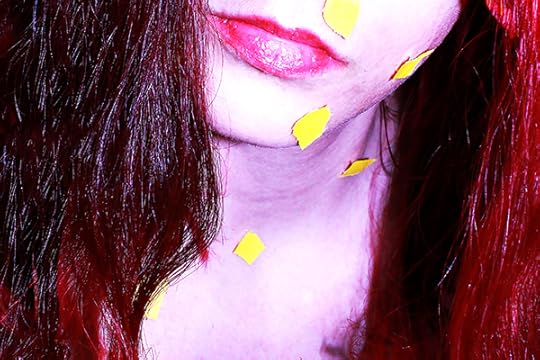
It’s hard to gain acceptance about a condition that you didn’t want and never asked for. The difficulty in coming to terms with having a chronic disorder that causes lesions on the skin can be overwhelming in day-to-day life. How can a person look at their skin and be okay with what they see? This is something I had to learn before having the opportunity of being on The Doctors and receiving effective treatment for skin picking from Karen Pickett.
First, you must accept where you are at in your journey. If you are reading this, you’re already on your way to educating yourself about dermatillomania while trying to find ways to live a more peaceful life. In never expecting to be on a daytime talk show getting therapy, I became non-judgmental about how the marks on my skin defined me. Instead of continuing to blame and hate myself during my teens and early twenties, I looked at my life from the view of living in an alternate society; one where marks don’t signify the false stigmas we’ve worried about (looking unhygienic, linking back to drug use, etc). A world where people see marks as mere discolorations of the skin; if everyone else was okay with me having a disorder, would I be?

(c) WForrest 2017
To an extent, the answer is yes. We would struggle with time management while engaging in the behavior but we wouldn’t have to cancel social outings or feel the need to spend additional time covering up our marks because of the shame associated with our appearance after picking. This wasn’t enough for me to accept, so I needed to find ways to appreciate my body. Through modeling I was able to see myself through another perspective. In seeing fully edited images that removed my marks and scars, I was able see past the spots that covered me all over. Since I developed this disorder as a child, I do not remember having clear skin; in seeing a person behind the marks, I realized that there was more to me that I couldn’t see because I was trapped in my own world of isolation.
The greatest way I gained acceptance about this disorder was through connecting with others who share the same disorder. It started by joining online communities as an observer, then I became active a year before FOREVER MARKED: A Dermatillomania Diary was released. With the positive feedback of my memoir from the community, I was emboldened to become a writer for various platforms while getting involved with The TLC Foundation for BFRBs and Canadian BFRB Support Network. Had I not opened myself to a world with others who struggle the same way I did, my feelings of loneliness would have increased as my exposure to others would have been non-existent. In reading your experiences in forums and through PMs, a lot shame was lifted because I recognized that my personal self talk was unreliable— if flawed thinking about myself didn’t apply to your stories, why would I apply the double standard of being deserving of shame and embarrassment?
While you don’t need to model in front of a camera or be active in the Body-Focused Repetitive Behavior (BFRB) community to gain an acceptance of living with this disorder, it can transform how you see yourself living with dermatillomania. Living with it may not be your preference but understanding how it affects your life can be useful in seeing how the disorder manifests moment-to-moment. I want you to know that…
You have permission to love yourself with your marks.
You do not have to feel ashamed of something you cannot control.
You are worthy of being accepted no matter what the condition of your skin is.
This disorder does not define you- it’s only one part of you.
Check out the five star documentary Scars of Shame and Angela’s ground- breaking memoir FOREVER MARKED: A Dermatillomania Diary. Like Angela on Facebook, follow her on Twitter, and join her on instagram. Subscribe to her blog for updates on her recovery book, embracing dermatillomania.
September 12, 2017
Resource Review: Laura Barton’s “Project Dermatillomania: Written on Our Skin”
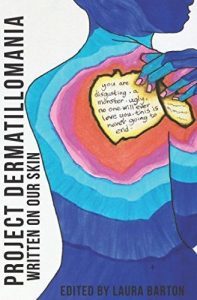 In being the second title in the series, Project Dermatillomania: Written on Our Skin (PD2) provides a vivid look into the lives of many women who have Excoriation Disorder (aka “Dermatillomania”). The 116 pages of this collective includes poems, personal stories, and artwork that conveys the severity of this often misunderstood disorder while providing intimate insight into the lives of the 19 contributors of this book, including its author Laura Barton.
In being the second title in the series, Project Dermatillomania: Written on Our Skin (PD2) provides a vivid look into the lives of many women who have Excoriation Disorder (aka “Dermatillomania”). The 116 pages of this collective includes poems, personal stories, and artwork that conveys the severity of this often misunderstood disorder while providing intimate insight into the lives of the 19 contributors of this book, including its author Laura Barton.
For the sake of full disclosure, Laura and I have a friendship that grew through our passion of spreading awareness about Dermatillomania and other BFRBs. We have worked together with the Canadian BFRB Support Network since its founding in 2013, with my contributions being mainly online due to not living in Ontario. I had the opportunity of meeting her at the 2015 TLC Conference in Washington, DC and have always admired her tenacity and will, along with her dedication to the proper dissemination of facts about BFRBs.
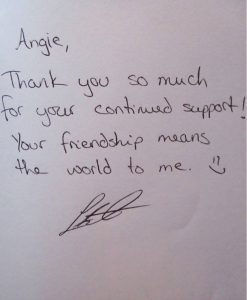 When I first received my copy of PD2 I was excited to see if she had autographed it, which, to my delight, she did! After thumbing through the book I was struck by how structured the template of the book is with contributor’s names, pictures, and locations being listed (or anonymously) in an engaging format that allows you to recognize that the words and images included in this book are written by real people who have had to travel down the isolating path of having Dermatillomania- which is evident throughout every submitted piece of work in PD2.
When I first received my copy of PD2 I was excited to see if she had autographed it, which, to my delight, she did! After thumbing through the book I was struck by how structured the template of the book is with contributor’s names, pictures, and locations being listed (or anonymously) in an engaging format that allows you to recognize that the words and images included in this book are written by real people who have had to travel down the isolating path of having Dermatillomania- which is evident throughout every submitted piece of work in PD2.
Upon receiving my copy from Laura, I had a worry about the length of this book. While it is only 16 pages longer than the first part of the series, Project Dermatillomania: The Stories Behind Our Scars (PD1), I feared that with many more contributors that it wouldn’t have as much of an impact on me as PD2’s starting book did. In reading through roughly 30 pages, I realized how emotional the content is and it exceeded my expectations.
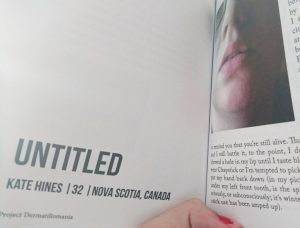 The introduction is immediately inviting, as you read that this book started as a thread from Barton asking people in an online skin picking forum to contribute to it. In our tight-knit community, I know a few of the names in the book and was excited to see their accounts of living with Excoriation Disorder. I was surprised to see an unfamiliar name with my province listed under “location”, which was Kate’s story from Nova Scotia! Seeing that someone only 1 year older than me lives nearby is further confirmation that I didn’t have to be alone growing up had there been awareness and resources available to bring this issue to light.
The introduction is immediately inviting, as you read that this book started as a thread from Barton asking people in an online skin picking forum to contribute to it. In our tight-knit community, I know a few of the names in the book and was excited to see their accounts of living with Excoriation Disorder. I was surprised to see an unfamiliar name with my province listed under “location”, which was Kate’s story from Nova Scotia! Seeing that someone only 1 year older than me lives nearby is further confirmation that I didn’t have to be alone growing up had there been awareness and resources available to bring this issue to light.
Doris’ addition to PD2 struck me because of the similarities in the way we convey our story. While my path didn’t lead me to a Master’s degree, the need for perfection in various aspects of life (including academia) resonated with me along with the speech she uses to present her experiences with this disorder.
One of the women I’ve seen in the forums, Nikki, has a unique story with a life of struggles, which I relate to in severity although not in occurrences. She became a therapist to be a beacon for those with Dermatillomania and her honesty about her flaws as a human being only solidifies her position as a compassionate therapist who is dedicated to helping those who are suffering despite her own struggles.
Kimi’s story was interesting because of the cultural differences she discusses. The part that sticks with me is how she was first introduced to the feminine culture of Avon meetings with women transfixed on beauty products, which was a foreign concept to her. It makes me think more about the push on women to appear flawless, which can be a driving factor in having Dermatillomania. She also talks about familial ties and each one’s reactions to her picking despite having their own mild to moderate forms of this disorder.
 The criticisms I have of this book pale in comparison to the benefits of having read it for further insights from everyone who contributed to this book. I caught a few minor errors and the lines were closer to each other than I had anticipated. A detail I am torn about is how many contributors included a definition and explanation about the disorder in their section; while it’s nice to hear how each person sees Dermatillomania, it occurred too often which took away from what else could have been included. With Laura’s explanation of it in the introduction, I found that book may have benefited from this repetition. It is not the fault of anyone involved but if this series continues, as I expect it might, I would like to see more stories from people of different regions, races, ages, genders, sexualities, religions, and socio- economic backgrounds to add to the whole picture of who Dermatillomania affects.
The criticisms I have of this book pale in comparison to the benefits of having read it for further insights from everyone who contributed to this book. I caught a few minor errors and the lines were closer to each other than I had anticipated. A detail I am torn about is how many contributors included a definition and explanation about the disorder in their section; while it’s nice to hear how each person sees Dermatillomania, it occurred too often which took away from what else could have been included. With Laura’s explanation of it in the introduction, I found that book may have benefited from this repetition. It is not the fault of anyone involved but if this series continues, as I expect it might, I would like to see more stories from people of different regions, races, ages, genders, sexualities, religions, and socio- economic backgrounds to add to the whole picture of who Dermatillomania affects.
I would rate this book a 9.5 / 10, which is the same rating I gave for PD1- but for different reasons. Aside from the personalized template I enjoyed seeing more references to outside resources, something Barton admits happened due to the insurgence of awareness over the past few years and her experience in already having written a book. The striking depth in the poetry showcases the talents of each individual while the placement of artwork is a wonderful transition from its heavy, yet relieving, emotional content. Similar to the its book, Project Dermatillomania: Written on Our Skin is another book that is guaranteed to make you feel less alone if you have this disorder.
If you would like a copy of either Project Dermatillomania books, please visit its website. follow Project Dermatillomania on Facebook and Twitter to keep up with potential opportunities! To read more from Laura Barton, check out her Facebook page and see her articles from The Mighty, Healthy Place, Healthy Minds Canada, and more!
August 30, 2017
I Needed BFRB Awareness in Grade School
 It wasn’t until the end of my first semester of my first year in university that I first heard the term Psychogenic Excoriation. In December of 2004, it was my Dermatologist who broke the news that the marks on my skin were the result of a psychological influence rather than a physical one. As someone who had began picking her skin regularly before the age of 10, I was angry that I was made to feel alone by professionals who did not know or bother to explain why I had to keep engaging in this daily ritual that resulted in visible wounds to my skin. I had seen many mental health professionals who brushed it off by suggesting I’d grow out of it along with a few who made insensitive comments about a behaviour I was deeply ashamed of admitting.
It wasn’t until the end of my first semester of my first year in university that I first heard the term Psychogenic Excoriation. In December of 2004, it was my Dermatologist who broke the news that the marks on my skin were the result of a psychological influence rather than a physical one. As someone who had began picking her skin regularly before the age of 10, I was angry that I was made to feel alone by professionals who did not know or bother to explain why I had to keep engaging in this daily ritual that resulted in visible wounds to my skin. I had seen many mental health professionals who brushed it off by suggesting I’d grow out of it along with a few who made insensitive comments about a behaviour I was deeply ashamed of admitting.

Grade 5, before my father’s brain injury
Thinking back to the 90s and early 2000’s lead me to imagining an alternate reality where Body-Focused Repetitive Behaviors (BFRBs) were as well-known as other mental health afflictions and discussed as openly as physical conditions are. While it is not something I dwell on, it gives me incentive to continue pursuing awareness to ensure that we change the future of children who have BFRBs and who may not be surrounded by anyone knowledgeable about them, let alone a practitioner who is able to treat them. What would life have looked like for my nine year old self who was engaging in a seemingly harmless behavior if the adults in my world knew what was going on and how it was affecting me? Could something have been done to intervene on my skin picking or would I have spiraled out of control with accompanying mental health afflictions such as depression, anxiety, and trauma affecting me as deeply as it did?
The senior years of elementary school would have been the perfect time to learn about these mental health afflictions at an age-appropriate level. If taught from a simple, non-judgemental, place I would have still felt alienated as I did in grade six when peers would look at me in health class during discussions about acne as if I was going to add in a personal perspective. However, knowing there was a name for my action would have made me realize that because it had a diagnosis that there were others in the world who knew what it was like to have the same difficulties I did.
By the time we reach middle school, we should all be loosely educated on mental health. With many professors in universities still not delving into BFRBs to prospective treatment providers, the requirement of presenting it in grade school would be as basic as the traditional teaching method of telling youth the definition of a term. With many mental health afflictions coming to fruition during the teenage years, it is an imperative topic to discuss alongside health instead of as an additional subject.

Grade 6 (age 12). Still wearing my turtleneck to hide the damage caused to my upper chest, shoulders, and back.
When we think of school, many of us think of a public arena where we send our kids to in order to be prepared for the real world. However, there is a lot that the school system is not equipped to handle due to a heavy workload which includes a variety of topics to touch in such a short time. When I think back of my time in school, I hate how well I could solve a quadratic equation or regurgitate information from a textbook but didn’t know how to fit into an alienating world that seemed unwilling to accept me for my appearance or the repetitious behavior that caused it.
We don’t prepare youth of today for the real world through public education. We teach them to retain as much information as possible in the shortest amount of time in order to obtain a high test score. We have replaced courses with practical life skills for those with higher academic requirements that look good on post-secondary applications, which is where we fail to prepare students for life. Had there been a focus on the well-being of students instead of limiting knowledge to the arts (which are always on the line to be cut) and sciences, there would have been more room for health and living skills that not all families have access to.
Instead of taking additional math courses I would have personally benefited from taking health-related classes along with home economics. With many classes being mandatory for high school graduation but not in our field of choice, there would have been lifelong rewards in having more information about mental health because knowledge is empowering. I would have greatly benefited in knowing I wasn’t alone early on in life instead of struggling through school as isolated as I felt. What I would have learned about BFRBs and other mental health afflictions (along with self-care strategies) would have carried with me into my adult years instead of the forgotten recollections of complicated mathematics or everything I crammed for the night before each irrelevant test.
Check out the five star documentary Scars of Shame and Angela’s ground- breaking memoir FOREVER MARKED: A Dermatillomania Diary. Like Angela on Facebook, follow her on Twitter, and join her on INSTAGRAM. Learn more about her upcoming recovery memoir with karen pickett, lmft, embracing dermatillomania: my recovery story by subscribing.
January 16, 2017
The Fetishization of Dermatillomania
 With awareness of Body-Focused Repetitive Behaviors (BFRBs) beginning to gain traction across the world, it is important to discuss how disorders such as how Dermatillomania affects a person’s quality of life. From social isolation to embarrassment of marks, most people who compulsively pick at their skin keep it a secret so that they won’t be judged or shunned by friends, family, coworkers, and the rest of the world.
With awareness of Body-Focused Repetitive Behaviors (BFRBs) beginning to gain traction across the world, it is important to discuss how disorders such as how Dermatillomania affects a person’s quality of life. From social isolation to embarrassment of marks, most people who compulsively pick at their skin keep it a secret so that they won’t be judged or shunned by friends, family, coworkers, and the rest of the world.
One way awareness has been raised has been through the unfortunate rise of cyst- breaking videos available online. Dr. Sandra Lee (aka “Dr. Pimple Popper”), has become prolific in sharing graphic videos from her dermatological practice. With millions of views on her channel and videos, why are people watching these videos? Do they all have Dermatillomania to a varying degree?
To the latter question: No. Many people are fascinated with the human body, what it is capable of, and the things that can go “wrong” with it. Dermatillomania is a condition that causes a person to pick or scratch at one’s own body compulsively, with negative consequences coming from failed attempts of being able to stop the behavior. Others watch them as a guilty pleasure of deriving some enjoyment from these videos.
Not all people with Dermatillomania like these videos. Some find them (myself included) cringe-worthy while others find that they help with their own urges. Instead of getting full relief from picking at oneself, a person who is partial to these clips can instead turn one on and receive the stimulation by watching someone else go through the motions of picking. That, or be triggered to find one an imperfect mark on themselves to replicate.
It can also set a harmful precedent to encourage breaking zits or fixating on a minefield of blackheads, which is where many pickers have problems with, cognitively. Seeing others engaging in these behaviors in an encouraged way (through virality and viewer’s reactions) on camera can normalize obsessive picking behaviors. While most people in the world pick at their skin occasionally for the sake of self-grooming, people with Dermatillomania find it nearly impossible to stop picking on their own.
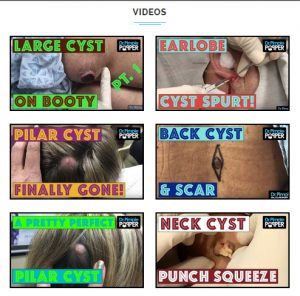
Salacious advertising
The videography section of Dr. Lee’s website is designed to grab attention in the ways that porno pop- ups do. It’s marketed in an edgy, fun, and in-your-face way, which goes along with how she wants her channel to be received by the public. Maybe I wouldn’t have as much of a problem with her sharing her videos of her profession online had she not discussed Dermatillomania in what could be perceived, as an interchangeable obsession. Instead, when these videos are shared and “Dermatillomania” is mixed into the conversation irresponsibly, our struggles can appear superficial.
The emotional pitfalls of BFRBs are serious and should not be minimized through fetishized videos meant to evoke strong emotions. The shock factor these videos have given the public has been coupled with a tinted view of what Dermatillomania is. Based on the success of Dr. Lee’s sensationalized videos, her brand of awareness will reach further than the current literature and resources on this disorder to educate about this topic. The question is, do we want our condition to be shared around the world through reputable sources or exploitative means?
Check out the five star documentary Scars of Shame and Angela’s ground- breaking memoir FOREVER MARKED: A Dermatillomania Diary. Like Angela on Facebook, follow her on Twitter, and join her on Tumblr.
November 23, 2016
Leaving Anxiety Class Was Better for my Mental Health

“Why are you challenging me, Angela?”
When the lead therapist abruptly cut me off in anxiety group with ten other clients during the fourth week of anxiety class, it felt like I had gone from a safe learning environment to being put in the hot seat. Immediately, I felt my body flush with a stark warmth and I started shaking. With tears welling in my eyes and voice quivering, I muttered “I can’t do this” and started putting my jacket on. Then he said, “You can either sit down or leave. You’re being disruptive.”
I tried to get a few words in to answer the initial question to which he replied while slowly shaking his head in a “no” motion,
“Now is not the time. Not the place.”
I was even more baffled because I was willing to discuss and de- escalate the situation so class could continue. While my voice was quivering and unsteady, I did not raise it or cause what was now officially a situation. Instead of defending myself in that moment, I turned to the group of women in front of me and quickly apologized if my behavior had disrupted their learning experience and left the situation. Had I engaged in this judgmental and accusatory provocation, others in the room could have been triggered or feel more uncomfortable than the situation itself had caused. I later learned a few “felt sorry for me” with a few even admitting to similar experience with this therapist.
While this may sound like a normal disagreement between a client and therapist, what preceded these events was what was intended to be an inquiry about the Acceptance- Commitment Therapy (ACT)/ mindfulness meditation we were doing. Fifteen minutes earlier he appeared to be annoyed that I didn’t plant both feet on the floor to do the meditation. Despite knowing about my four year struggle with chronic back pain he insisted again that this is it’s how it’s done, despite the low quality recording instructing us to lie down. He was displeased that I could only lower my right foot while my left leg was bent upward to relieve pressure from my throbbing SI joint.

With this therapist’s accurate proposal of being non-judgmental to all thoughts, feelings, sensations, throughout the body scan I couldn’t help but ask how it wasn’t judgmental to try and prevent something that is happening in the moment without just simply observing it. Most people will feel relaxed and tired; I have been told by many reputable therapists it was OK to fall asleep during a meditation because it means that the person is engaging while getting in touch with the needs of their body. There is not supposed to be a right or wrong way, right or wrong feelings that need changing- the point is to observe what’s going on in the present moment non-judgmentally.
Last week we were advised to not do the body scan exercises before bed because it shouldn’t be used as a sleep aid or relaxation technique. However, I have found relief doing a Jon Kabat- Zinn half hour meditation before bed allows me to relax enough to sleep — something that can be challenging to get when there aren’t many options for relaxation when chronic pain doesn’t allow you to get comfortable.
While sharing with the group about how I benefit from this practice, he was slowly shaking his head with the same grimace noted above instead of being mindful or actively listening to what I had to say. Instead, his explanation was “I’ve been doing it for 10 years and this is what works best“. When I tried sharing from my point of view, including how being mindful to my pain makes it worse (which he expressed is something that shouldn’t happen) he sternly interrupted with, “Why are you challenging me, Angela?“. I knew immediately I wasn’t in an open environment conducive to receiving the help I was seeking out- somewhere I could learn what I need to know, or do, in order to improve my anxiety. To healthy practitioners, challenges on material and concepts are seen as an opportunity to learn from the perspective of a client instead of a need to go on the defense.
I wasn’t allowed to communicate questions about the material, and therefore my overall well-being. A few people have advised me to speak with him to clear things up but I have seen this type of insecurity manifest many times; I know better than to put myself in a situation with people who feel entitled to act out. Upon hearing similar stories from those who personally messaged me, I am confident that this person has no reason to change. He reacted insensitively instead of taking a moment to explain or even say, “I don’t have time to delve into it now but we can speak about it later”. Whether it be Dr. A in FOREVER MARKED: A Dermatillomania Diary or this person now, I am finding it hard to have enough resolve in a one-on-one scenario locally to trust that I can feel comfortable enough to seek out the help I need or disclose more of my vulnerabilities without fear of being attacked or pushed away by professionals.
Even if I was unreasonable, he should be equipped to handle a plethora of symptoms and behaviors from clients instead of acting out by alienating a person who was there to learn- in an anxiety class, of all places. Instead of seeing my inquiries as an invitation to discuss different reactions to the body scan, he not only accused me of being disruptive but also invalidated my experiences. If a therapist is willing to create a hostile situation out of legitimate concerns, there is nothing I can do- or be- that will prevent this manipulation from re-occurring.
I have learned a lot about ACT over the last two years after appearing on The Doctors with Karen Pickett to get help for my skin picking. When completed, my second memoir EMBRACING DERMATILLOMANIA: My Recovery Story will include components from this modality of therapy, which is what I believe was vital in addressing my chronic skin picking. However, I shouldn’t need the professional component of my interest in mental health information as an excuse to probe further into the instructions we were given. I want to understand, retain, and practice what is being conveyed so that I can improve parts of my life I’m struggling with.
It’s better to know what you have control over and what you need to let go in order to preserve your mental health. I will protect myself by not entering a hostile environment when I have already seen indicators of aggression from someone who is supposed to be leading us judgmentally to a better life. If I continue down this path, I’m simply putting myself in harms way. Sometimes it’s better to accept what you cannot change and move forward without the “help” of a combative professional if you’re unable to trust they have your interests at heart.
Check out the documentary Scars of Shame and Angela’s memoir FOREVER MARKED: A Dermatillomania Diary. Like Angela on Facebook, follow her on Twitter, and join her with the hundreds of other BFRB sufferers on Tumblr.
July 20, 2016
How Pokemon Go is Bringing My Life Back
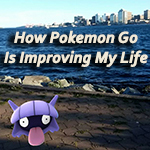 I was only twelve years old when my cousin first introduced me to a game boy emulator with the first generation of Pokemon games downloaded on it. I had never played a game as captivating as Pokemon Blue and by the end of the visit at my aunt’s house, I was told that four hours had passed when it only felt like I was only playing for half an hour. Years later, I am one of the many Pokemon Go players who are eager to catch these iconic creatures and become a worthy opponent in nearby gyms- but for more reasons than to just “catch ’em all”.
I was only twelve years old when my cousin first introduced me to a game boy emulator with the first generation of Pokemon games downloaded on it. I had never played a game as captivating as Pokemon Blue and by the end of the visit at my aunt’s house, I was told that four hours had passed when it only felt like I was only playing for half an hour. Years later, I am one of the many Pokemon Go players who are eager to catch these iconic creatures and become a worthy opponent in nearby gyms- but for more reasons than to just “catch ’em all”.
Video games have always been an integral part of my life. Despite not speaking until I was four, I was proud that I beat Super Mario Brothers 3 on my new NES at five. Also in that same year I clung onto Tetris because I was able to reach levels that no one in my family could match. With the upgrades of an SNES, N64, PS1 and PS2 throughout the years, I have easily played thousands of hours of games that have served as entertainment to boredom and an escape from my reality.

A Pidgey in my neighborhood!
I had the beginnings of Dermatillomania at 10 years old, just before my father had his brain injury, but I didn’t indulge in video games chronically until afterward. I was uncomfortable with my appearance, didn’t fit in with others, and video games served multiple purposes. I have been whisked away for hours at a time by turn-based RPG adventures, have become number one in old popular racing games, and strained my brain with a variety of strategy games. It kept me busy, entertained, out of trouble, introverted, and isolated with what I couldn’t control, but it gave me relief from stresses in my life.
This isn’t the part of me that has been talked about. According to some outlets, I’m simply a woman with a disorder. I don’t have a personality, hobbies, or rights and I certainly wouldn’t fit the narrative that others want to create of a drab soul who does not know of any happiness. Luckily my life story was correctly portrayed in the documentary Scars of Shame and I am seen playing my various old consoles as a way of keeping myself and my hands occupied so that I didn’t compulsively pick my skin. Scars of Shame was filmed years before I appeared on “The Doctors” with Karen Pickett for help with my Dermatillomania and in it I discuss how I believed video games helped in distracting me from my picking. During my therapy I learned that my “automatic” picking worsens if I multi-task on electronics or play video games for too long. As a result I’ve had to calm down the stimulation and baseline anxiety by using mindfulness techniques instead of putting my mind, and potentially picking, into overdrive.
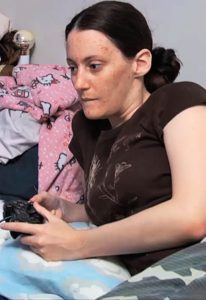
Screenshot from “Scars of Shame“.
Pokemon Go challenges my immediate fear of leaving the house by replacing it with an enticing activity that encourages me to get out of the safe confines of my home. After living with chronic pain on the lower left side of my back for 3.5 years, which has since improved by 85%, I am still afraid to leave the house in fear of becoming too weak because of the muscle deterioration that occurred while I waited for to be properly diagnosed.
Despite being an advocate who has conquered picking with the same percentage of success as my chronic pain, my mental health did not improve once my back pain simmered down. I have had to deal with with the results of a traumatic medical procedure from this past April which now include panic attacks of the vomiting, diarrhea, and the- sickening- stench- of- sweat kind. I’ve had withdrawals from a heavy dose of Gabapentin, an anti-epileptic medication with anti-anxiety properties used for pain, which lessens my desire to leave the house. The picker in me finds it therapeutically exhilarating to swipe Pokestops because of a certain satisfaction I get after tapping the rewards that it spawns. My anxiety in public decreases when I have “goals” in my brain related to the game, which makes it easier to silence generalized worries while in the outside world.
While chasing Pokemon with my husband I noticed how people are hanging around parks and landmarks more than they have in recent years. Pokemon Go is a real world adventure that pushes people to step out for fresh air instead of hiding away from it. While at one of my city’s hot spots for Pokemon, I had people engage in fun conversation with me about the game. Human interaction of this kind with a new sense of community didn’t exist until the release of this game. While the news likes to focus on the misfortunes and dangers of Pokemon Go, I see hope that this game is improving lives by allowing us to connect to others and our environment.
Humans are not made to be cooped up, even if some of us have a fear response that tells us that it’s better to remain indoors than be exposed to uncontrolled variables outside. Unlike any other game I’ve obsessively played in the past, Pokemon Go has encouraged me to walk a few steps further to hatch eggs and reach Pokestops, which will help in my physical recovery. As for my mental health, having the incentive to get out the front door is a step in the right direction toward learning how to rebuild myself and maintain my baseline anxiety levels.
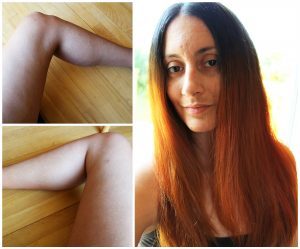
Check out the five- star documentary Scars of Shame and Angela’s ground- breaking memoir FOREVER MARKED: A Dermatillomania Diary. Like Angela on Facebook, follow her on Twitter, join her on Tumblr and follow her on Instagram
Subscribe via e-mail for updates about the upcoming book
“Embracing Dermatillomania: My Recovery Story“.



